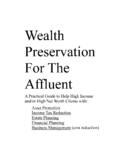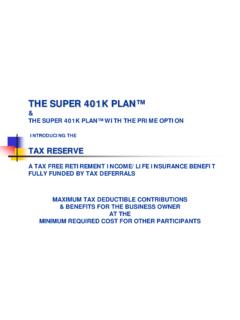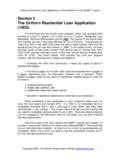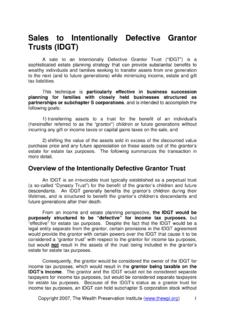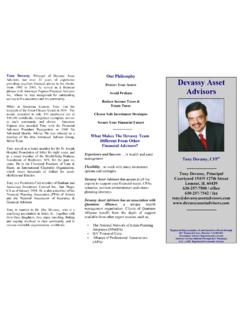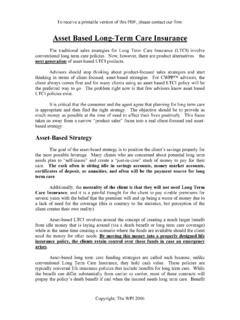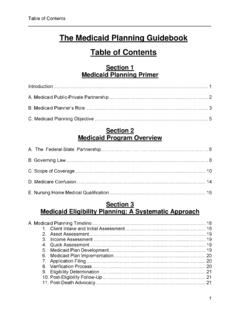Transcription of (3 Hours; 85 Pages of Text) - The Wealth Preservation ...
1 Outline for the CWPP Certification Course Copyright--The Wealth Preservation Institute ( ) 1 Asset Protection (3 Hours; 85 Pages of Text) Domestic Asset Protection 1) Introduction a) Why advisors need to know asset protection b) Why other certification programs ignore asset protection c) Which clients need asset protection? d) Negligence (The legal definition with examples) e) Directors and officers, employees f) Personal service exceptions 2) Fraudulent Transfers a) Actual Fraud b) Constructive Fraud i) FMV ii) Damages known iii) Insolvency c) Defenses i) Legitimate business purpose ii) Transferring assets 3) Existing Laws a) Homestead exemption b) Life insurance c) Annuities d) Wage protection 4) Retirement Plans a) Retirement Plans i) ERISA plans ii) Non-ERISA plans iii) IRAs 5) Typical Asset Protection Plans (that do not always work) a) Co-Ownership i) Joint tenancy ii)
2 Tenants in common iii) Tenants by the entireties b) Community property states 6) Corporate Entities a) Sole proprietors b) Partnerships Outline for the CWPP Certification Course 2 Copyright--The Wealth Preservation Institute ( ) c) Corporations (C- and S-corporations) d) Limited liability companies e) Piercing the corporate veil f) Keeping the entity valid g) Types of Creditors i) Inside ii) Outside h) Director s and officer s liability i) Trustee/Fiduciary liability 7) Limited Liability Companies/Family Limited Partnerships a) Differences between LLCs/FLPs and C-or S-corporations b) Charging orders c) Potential problems with LLCs/FLPs d) What types of assets should be held in LLCs/FLPs e) Where to incorporate 8) Trusts as Asset Protection Tools a) Types of trusts i) revocable ii) irrevocable iii) intervivos iv) testamentary b) Dynasty trusts c) Alaskan asset protection trusts (and other self settled trusts) 9) Personal Residence Protection a) Homestead exemption b) Tenants by the entireties c) Qualified Personal Residence Trust (QPRT) d) LLCs and FLPs e) Debt Shields (Equity Stripping) 10)
3 Accounts Receivable (A/R) Asset Protection a) A/R Leveraging overview b) A/R Leveraging done right c) The finances of A/R Leveraging Plan d) Is A/R Leveraging right for your clients? Offshore Asset Protection 1) Offshore Asset Protection a) Why offshore b) Pitfalls to offshore planning c) The Anderson Case Outline for the CWPP Certification Course 3 Copyright--The Wealth Preservation Institute ( ) 2) Offshore Limited Liability Companies (LLCs) 3) Offshore Trusts a) Typical offshore setup b) Potential problems with a Foreign Trustee c) The Protector d) Contempt of court e) What defenses are available for contempt?
4 4) Closely Held Insurance Companies (CICs) Estate Planning The Basics (1 Hour; 21 Pages of Text) 1) Introduction 2) Wills a) How often should a will be updated? b) Holographic wills c) Disinheriting a spouse 3) Durable Powers of Attorney a) What is a Durable Power of Attorney (DPA)? b) Why would such a document save time and money? c) Types of Durable Powers d) springing powers e) Delegating medical treatment options and/or directives f) What is a Living Will? 4) A&B, Marital, or Living Trusts a) What are the benefits of A&B trusts? b) Avoid Probate c) Maximize Estate Tax Exemptions d) Examples e) Revocable 5) Irrevocable Life Insurance Trusts (ILIT) a) Life Insurance b) Income tax free death benefit c) Estate tax free death benefit d) ILIT has to own the policy 6) Dynasty Trusts Outline for the CWPP Certification Course 4 Copyright--The Wealth Preservation Institute ( ) 7) Divorce Protection a) How do Clients Protect Inherited Assets in a Divorce?
5 B) Prenuptial Agreement 8) Generation Skipping Tax (GST) a) GST Exemptions b) Why use a Generation Skip? c) Limits on the Dynasty Life Insurance (1 Hour; 28 Pages of Text) 1) Introduction a) The Basics 2) Type of Life Insurance Policies b) Term Life Insurance i) Guaranteed Level Term (GLT) ii) Annually Renewable Term (ART) iii) Return of Premium Term (ROPT) iv) Conversion privileges v) Conclusion on term life 3) Cash Value Life Insurance a) Cash Surrender Value (CSV) b) Cash Account Value (CAV) c) Policy Withdrawals d) Modified Endowment Contract (MEC) i) MEC tax treatment ii) Technical definition of a modified endowment contract iii) The seven-pay test iv) Refund of Excess Premiums v)
6 Benefit reductions within the first seven contract years vi) Reductions of Benefits Attributable to Nonpayment of Premiums vii) Conclusion on the MEC rules e) Policy Loans 4) Whole Life Insurance a) 10 Pay and 20 pay Whole Lives b) Full Pay Whole Life c) Whole Life Insurance Conclusion Outline for the CWPP Certification Course 5 Copyright--The Wealth Preservation Institute ( ) 5) Universal Life a) Fixed Universal Life b) Accumulation Universal Life c) No-Lapse (Secondary Guarantee) Universal Life (Also known as no-cash value UL) 6) Variable Universal Life 7) Equity Indexed Universal Life (EIUL) a) How are investment returns calculated in an EIUL?
7 B) Pros and Cons of the new EIUL policy: c) EIUL vs. Whole Life 8) Survivorship or "2nd-to-die" Life Insurance 9) Policy Riders 10) Underwriting Section 79 Plans (1 Hour; 20 Pages of Text) 1) Introduction 2) Requirements of Code Section 79 a) Group term life insurance b) $50,000 of term life coverage c) Employee funding formulas i) Full time employees d) Discriminatory funding e) Individual employee selection 3) Group Term Life and Permanent Benefits a) Benefits not considered permanent b) Cash value life insurance c) Federal income taxes i) Cost of permanent benefits d) Example e) Treatment of dividends with cash value life f) Allocation of permanent benefits to various employees tax years 4) Employee Payments for Permanent Benefits a)
8 Individual life policies as group policies b) Deduction of Premiums i) Business deduction Outline for the CWPP Certification Course 6 Copyright--The Wealth Preservation Institute ( ) 5) Section 79 Plans after IRS adjustments to Split-Dollar Life Insurance 6) Practical Use of Section 79 Plans 7) What s Wrong With Section 79 Plans 8) Potential Penalty Exposure a) Code section 6662 College Planning-A Wealth Preservation Challenge (2 Hour; 57 Pages of Text) 1) Saving for college and paying for college. a) Taking control of the cost b) Other ways to lower costs c) Make sure to know the true costs 2) Paying for College a) Other People s Money to Pay for College i) Financial Aid -Criteria for financial aid ii)Need Based Aid -Needs Analysis Formula -Cost of Attendance (COA) -Expected Family Contribution (EFC) -Federal Methodology Formula (FM) and the FAFSA forms -Institutional Methodology Formula (IM) and the CSS Profile forms -Simplified EFC formula example (FM) -EFC formula discussion -Parents Contribution -Student s Contribution b) Dates of Assessment c)
9 Need vs. Aid d) Applying for Financial Aid-Forms and Timelines e) EFC in depth i) Non-Assessable Assets ii) Non-Assessable Income iii) Financial Aid Income and Benefits: -Untaxed Income and Benefits (add backs): -Financial Aid Income Deductions: iv) Resources f) Merit Based Aid g) Private scholarships: h) Student Loans Outline for the CWPP Certification Course 7 Copyright--The Wealth Preservation Institute ( ) i) Tax incentives (Federal) i) Hope Scholarship Credit: ii)Lifetime Learning Credit: iii) Student loan interest deduction: iv) Deduction for qualified higher education expenses: v) Penalty free IRA withdrawals: j) Tax strategies k) Funds from extended family l) Controlling the Cost of College m) Using Parents Money to Pay for College i) Increasing cash flow for both retirement, lifestyle and college funding ii) Debt Consolidation iii) Parent loans for college 3) Saving for College and Retirement Investments a) Investment Options.
10 I) EE bonds ii) I-Bonds iii) Traditional IRA s iv) Roth IRA s v) Tax efficient mutual funds vi) Annuities vii) QTP s or 529 s viii) Coverdell Education Savings Accounts: (CESA) 4) The Safe College Plan A) College funding with NO stock market risk using FIAs (in a tax free and penalty free environment) 5) College Planning Using Cash Value Life Insurance a) CAUTION: b) Industry speak c) Pros and Cons d) Using Equity Indexed Life Insurance properly i) Example 1- it doesn t work ii) Example 2-it still doesn t work iii) Example 3-one that gets closer being financially viable iv) Example 4-one that works e) Overfunding a cash value life insurance policy for college planning and retirement income (it works!
